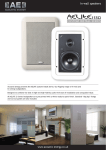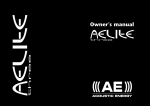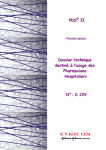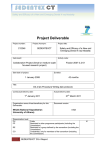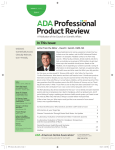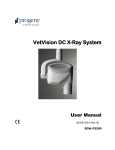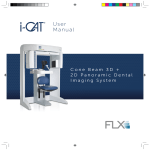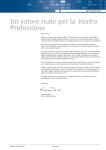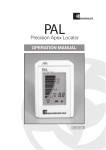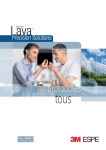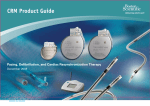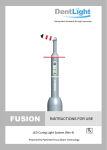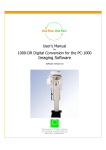Download ADA.org: Professional Product Review Summer 2006
Transcript
I N T H I S I S S U E Introducing the ADA PPR: Designed for You with Your Practice In Mind Carbide Burs Lab Notes 2 Practitioner Input 3 Buyer’s Summary Table 3 Posterior Composite Lab Notes 4-6 Practitioner Input 7 Buyer’s Summary Table 7 Panel Discussion 8 Digital Radiography Systems Primer Lab Notes 9 10 - 13 Practitioner Input 12 Buyer’s Summary Table 14 Buyer’s Checklist 15 The Back Page 16 Editor: David C. Sarrett, DMD, MS Welcome to the new ADA Professional Product Review (PPR)! We know you have other sources of product information and limited time to access them all. So what do we offer the busy practitioner? Information that is scientifically sound, unbiased, and clinically relevant. How do we plan to make sure that PPR is your source for professional product reviews? We earn your trust! Our evaluations are based on just what you yourself would look to, only on a far larger scale. We talk to your colleagues (hundreds at a time), test products in the ADA laboratories, and bring together the top experts who teach, research, or lecture in areas like restorative dentistry, endodontics, and infection control. We promise to put the needs of you, our readers, first by compiling information from the best available sources. With that goal in mind, we maintain contact with the manufacturers of the products we evaluate. For example, we routinely allow technical staff from companies to review our testing protocols, and for equipment that involves a learning curve, like the digital radiograph systems reviewed in this issue, we invite technicians to assist us with product set-up and training. In addition, we share with manufacturers data specific to their product prior to publication as part of our review process. We believe this affords us an opportunity to identify any possible anomalies in product performance before providing you with a review. For a full description of our guidance on manufacturer relations, visit “www.ada.org/goto/ppr”. We designed this newsletter specifically for ADA members. Four times a year, as a member benefit, you will receive a newsletter packaged with your issue of the Journal of the American Dental Association. Through December, we will be introducing the PPR to the dental community, sending issues to more than 150,000 people and institutions including practitioners, manufacturers, libraries, and dental schools. In 2007, the PPR will be available to nonmembers only on a subscription basis. Please look over this and future issues of PPR so you can see for yourself why PPR is your source for product information. And let us know what you think, by dropping me a line at “[email protected]”. Dr. Sarrett is a professor of Dentistry, and Associate Vice President for Health Sciences—Academic Affairs, Virginia Commonwealth University, Richmond, VA. He can be reached at “[email protected]”. Bringing Digital Radiography Into Your Office Over the last decade, the technology behind digital radiography systems has evolved, making incorporation of these systems into most dental offices feasible. This report offers some basic technological information as well as a review of some popular systems. In digital radiography, there are three types of detectors that take the place of conventional film: charge-coupled device (CCD), complementary-metal-oxide-semiconductor (CMOS), and photo-stimulable phosphor (PSP). We evaluated CCD and CMOS-based systems ISSN 1930-8736 David C. Sarrett, DMD, MS Editor, Professional Product Review for this review. Systems that use these types of solidstate detectors are called “direct.” When these sensors receive energy from the x-ray beam, the CCD or CMOS chip sends a signal to the computer and an image appears on the monitor within seconds. Systems that use PSP sensors (or “plates”) are called “indirect.” When these plates are irradiated, a latent image is stored on them. The plate is then scanned and the scanner transmits the image to the computer. For comparative information on CCD, CMOS, and PSP technologies, visit “www.ada.org/goto/ppr”. BluWhite (FG 557) Kerr Corp. 800-537-7123 www.kerrdental.com Carbide Burs We reviewed eight brands of straight, fissure carbide burs (557) : BluWhite (Kerr Corp.), Brasseler (Brasseler USA), Henry Schein (Sullivan-Schein), Midwest (Dentsply Professional), Miltex (Miltex, Inc.), NTI (Axis Dental Corp.), SS White (SS White Burs, Inc.), and Tri Hawk (Tri Hawk Corp.). In addition to laboratory testing, we collected input from 407 dentists about these products. Brasseler (557 FG) Brasseler USA 800-841-4522 www.brasselerusa.com Henry Schein (FG 557) Sullivan-Schein 800-372-4346 www.sullivanschein.com Lab Notes Midwest (FG557) Dentsply Professional 800-989-8826 www.professional.dentsply.com We purchased burs of each brand for testing in the ADA laboratories to determine run-out, permanent set, corrosion resistance, cutting rate, and loss of cutting rate. In developing some of our tests and determining whether products passed or failed, we referred to the standards published by the American National Standards Institute and the ADA.1 A full description of our test methods can be found on the ADA’s web site at “www.ada.org/goto/ppr”. Miltex (DFG557) Miltex, Inc. 866-854-8300 www.miltex.com NTI (H557-FG) Axis Dental Corp. 800-355-5063 www.axisdental.com BASIC TESTS CUTTING RATE Our Basic Tests challenge products against a performance standard, which products can either pass or fail. The Basic Tests for carbide burs were Dimensions, Run-Out, Permanent Set, and Corrosion Resistance.1 All of the brands we tested passed these tests. Here’s how these tests relate to clinical performance: Clinical Significance: Indicates how much material a bur will remove within a given time and how that value might decrease with use. Results: Tri Hawk and NTI burs had significantly better cutting rate than the others. Among the multi-use burs, only NTI showed no statistically significant loss of cutting rate between the first and second cuts, having been autoclaved between cuts. The mean Cutting Rate results, along with the Loss of Cutting Rate for multi-use burs, are shown in the Figures 1 and 2. • The diameter of 557 burs should be 1.0 (±0.08) mm at the working end.1 We confirmed these measurements by checking the Dimensions. SS White (FG-557) SS White Burs, Inc. 800-535-2877 www.sswhiteburs.com • Run-Out gives you a sense of cutting accuracy, indicating whether the bur will make a cut that is the same as the bur’s diameter. Tri Hawk (FG 557) Tri Hawk Corp. 866-Tri-Hawk (874-4295) www.trihawk.com Comments: For this test, we cut blocks of a machinable glass ceramic (Macor, Corning Inc.) under standardized load, air pressure, and water flow rate conditions. Admittedly, Macor is not tooth enamel and the results you would get through clinical use would not be the same as those obtained when cutting Macor; however, it often is used in laboratory testing to collect comparative data because it has similar physical properties to tooth enamel. • Permanent Set tests the bur’s ability to resist permanent deformation or fracture and provides an indication of the bur’s durability. • Corrosion Resistance demonstrates the bur’s resistance to corrosion after steam autoclave sterilization. For infection control, burs should be heat sterilized between patients.2 Tri Hawk is the only bur we tested that is supplied sterile; the others should be processed before use. REFERENCES 1. American National Standard/American Dental Association Specification No. 23—1982, Dental Excavating Burs. Chicago: American Dental Association. 2. Centers for Disease Control and Prevention. Guidelines for Infection Control in Dental Health-Care Settings—2003. MMWR 2003;52(no. RR-17):20, 22-23. Figure 2. Mean (±SD) Cutting Rate and Loss of Cutting Rate for Multi-Use Burs.* Figure 1. Mean (±SD) Cutting Rate for Single-Use Burs.*‡ 1st Cut 2nd Cut Henry Schein Miltex Brasseler Midwest SS White BluWhite Tri Hawk NTI‡ 0 100 200 300 400 Rate (mg/min)† 500 600 700 * Mean based on n = 10 † Measured in milligrams of machinable glass ceramic (Macor, Corning Inc.) cut per minute. ‡ All of these products performed differently based on statistical analysis (one-way ANOVA, p < 0.05). 2 ADA Professional Product Review VOL . 1 | I S S U E 1 0 100 200 300 400 500 Rate (mg/min)† 600 * Mean based on n = 10 specimens. Vertical black bar designates products that performed equally for Cut 1 based on statistical analysis (one-way ANOVA, p > 0.05). † Measured in milligrams of machinable glass ceramic (Macor, Corning Inc.) cut per minute. ‡ NTI performed equally well between Cuts 1 and 2 based on statistical analysis (one-way ANOVA, p > 0.05). 700 Practitioner Input concentricity, and whether the shank was compatible with their handpieces. The pie charts give an overall sense of how often the brands rated Excellent, Very Good, Good, Fair, Poor, or Unacceptable. For a precise breakdown of how respondents rated each feature, visit “www.ada.org/goto/ppr”. Pay special attention to the number of respondents. Ratings are more reliable when they are based on the opinions of more respondents. Via a web-based survey, we collected input from 407 dentists about their experiences with the products we tested in the lab. Of note, dentists reported having experienced instances when the bur had fractured during use for each brand. This is a good reminder to take precautions, like using high-volume evacuation and protective eyewear, when working with burs. On the survey, respondents were asked to rate their impressions of up to two brands of carbide burs based on corrosion resistance, durability, BluWhite (n=5) Brasseler (n=114) Henry Schein (n=36) Midwest (n=205) Miltex (n=2) NTI (n=14) SS White (n=173) Tri Hawk (n=10) Excellent Very Good Good Fair Poor Unacceptable Table 1. Buyer’s Summary for Tested Carbide Burs. Product (No. of Practitioner Input Respondents) Practitioner Input† Laboratory Performance* Price/ Bur‡ Supplied Sterile§ 11 $1.59 No 0 0 $1.99 No 22 48 8 $1.19 Yes 0 67 22 11 $1.23¶ No 82 36 31 27 6 $1.49 No Pass 79 22 40 25 13 $1.09 No NTI (n = 14) Pass 100 13 50 22 15 $1.40 No SS White (n = 173) Pass 84 26 37 25 12 $1.33 No Basic Lab Tests Lab Score for Other Tests (%) Excellent % Very Good % Good % OtherII % Midwest (n = 205) Pass 79 29 35 25 Miltex (n = 2) Pass 50 38 62 Tri Hawk (n = 10) Pass 100 22 BluWhite (n = 5) Pass 84 Brasseler (n = 114) Pass Henry Schein (n = 36) Single Use Multi-Use * Basic Lab Tests are Dimension, Run-Out, Permanent Set and Corrosion Resistance. Other Lab Tests: For single-use burs, this score is based on cutting rate for one cut; for multi-use burs a percentage score was calculated for the first and second cuts with the final score reflecting the average of those two. The best performer earned 100 percent and the others earned a percentage based on how they compared to the best. † Via a web-based survey, 407 dentists had the option of rating the performance of up to two brands. Indicates percentage of time a rating was selected for a product. Ratings are more reliable for products that have more respondents. ‡ MSRP as of February 2006 based on a purchase of 100 burs unless otherwise noted. Retail prices may vary. § For infection control, burs should be heat sterilized before use.2 Thus, burs that are not supplied sterile should be processed before first use. II Other: Sum of Fair, Poor, and Unacceptable ratings. ¶ MSRP as of Feb. 2006 based on a purchase of 10 burs. ADA Professional Product Review VOL . 1 | I S S U E 1 3 Aelite LS Posterior Bisco 800-247-3368 www.bisco.com Posterior Composite Resins Esthet-X DENTSPLY Caulk 800-LD-Caulk www.caulk.com For testing, we purchased eight brands of composite resins (Shade A3) marketed for use in posterior teeth: Aelite LS Posterior, Esthet-X, Filtek Supreme Plus Universal Restorative, Gradia Direct Posterior, GrandiO, Heliomolar HB, Herculite XRV, and Venus (Table 1). In addition to laboratory testing, we collected input from 413 dentists about their experiences with these products and hosted an Expert Panel discussion on the general topic of posterior composites (p8). Filtek Supreme Plus Universal Restorative 3M ESPE 800-634-2249 www.3m.com/espe Table 1. Filler Characteristics of Featured Products. Product Filler Gradia Direct Posterior GC America 800-323-7063 www.gcamerica.com Particle Size Aelite LS Posterior Silica, strontium glass 0.05-4 μm 74 Esthet-X Barium-fluoro-aluminum-boro-silicate glass 10-20 nm 0.02-2.5 μm 60 GrandiO VOCO 888-658-2584 www.voco.com Filtek Supreme Plus Universal Restorative Zirconia silica with cluster agglomerates 20-75 nm 0.6-1.4 μm 59.5 Gradia Direct Posterior Fluoro-alumino-silicate glass, organic filler 0.016-16 μm 65 GrandiO Silica glass 20-60 nm 0.7-1 μm 71.4 Heliomolar HB Silica, yttrium fluoride and copolymers 0.04-0.2 μm 46 Herculite XRV Barium-alumino-boro-silicate glass, colloidal silica 0.6 μm (avg.) 59 Venus Silicone dioxide, barium-aluminum-boron-fluoride silica glass 0.01-0.04 μm 0.7-2.0 μm 61 Heliomolar HB Ivoclar-Vivadent 800-533-6825 www.ivoclar.com Herculite XRV Kerr Corp. 800-537-7123 www.kerrdental.com Venus Heraeus Kulzer 800-431-1785 www.heraeus-kulzer.com Volume Fraction (%) Lab Notes We tested each brand in the ADA labs to document water sorption and solubility, shade matching to the manufacturer’s shade guide, color stability after water storage, polishability, depth of cure, flexural strength and modulus, radiopacity, maximum shrinkage stress, and rate of stress development. In developing some of our tests and determining whether products passed or failed, we referred to the standards published by the International Organization for Standardization and those from the American National Standards Institute and the ADA.1,2 We used the Optilux 501 curing light when preparing our test specimens. You can find a full description of the methods we used at “www.ada.org/goto/ppr”. BASIC TESTS Our Basic Tests challenge products against a performance standard, which products can either pass or fail. The Basic Tests for posterior composites were the Water Sorption and Solubility, Shade Matching, Color Stability, and Polishability Tests.1,2 All of these brands passed these tests. Here’s how the tests relate to the clinical performance of posterior composites: • Water Sorption and Solubility relate to the material’s long-term mechanical stability in an aqueous environment. Water sorption measures how Figure 1. Mean (±SD) Depth of Cure Values.*† Aelite LS Posterior much water will be absorbed by these materials that may lead them to expand once placed in the oral cavity; solubility shows how much material will leach out of the composite in an aqueous environment. We conducted these tests after storing the specimens in water (37°C) for 30 days. • Shade Matching verifies the color match between the cured composite and the manufacturer’s recommended shade guide for that product. • Color Stability is a screening test that checks whether the color of the material initially will remain stable in a moist environment. We assessed color stability after storing the specimens in water (37°C) for 30 days. • Polishability demonstrates the ability to attain maximum surface gloss with a polishing system (we used the Soflex system, 3M ESPE). Depth of Cure (DOC) Heliomolar HB Clinical Significance: Identifies the DOC achieved according to the manufacturer’s recommended curing time and offers guidance on the maximum increment-thickness that can be cured under similar conditions. Darker shades, lower light intensity, and increased distance between the light tip and the composite will decrease the maximum DOC. Esthet-X Venus Gradia Direct Posterior Filtek Supreme Plus Universal Restorative GrandiO Results: We tested three specimens of each brand and report the mean DOC in Figure 1. Herculite XRV 0 0.5 1.0 1.5 2.0 2.5 3.0 3.5 Cure Depth (mm) * Mean values based on n=3 specimens. Vertical black bars designate products that performed equally based on statistical analysis (one-way ANOVA, p > 0.05). † We used the manufacturer recommended cure time for these products. For Herculite XRV, the recommended curing time was twice that of the other composites (40 vs. 20 seconds). 4 ADA Professional Product Review VOL . 1 | I S S U E 1 4.0 Comments: Herculite XRV showed the greatest DOC, but the recommended cure time was twice that of the other products (40 vs. 20 seconds). Aelite LS Posterior and Heliomolar HB both had DOC < 2 mm, the manufacturers’ recommended increment thickness. Our results suggest that, when using either of these products, you may want to work with a smaller incremental thickness than those recommended by their manufacturers. Curing Lights: Curing lights will affect DOC. In our tests, we repeatedly confirmed that the curing light was functioning at 300 mW/cm2, according to the ANSI/ADA specification for curing lights.3 During the Expert Panel discussion (p 8), the importance of properly functioning curing lights was emphasized. “Often, the curing lights being used clinically are underpowered, leaving the composite under-cured,” said panelist Dr. Edward J. Swift Jr., professor and chair of Operative Dentistry, University of North Carolina School of Dentistry. Dr. Swift based his comment on a number of studies documenting the intensity of curing lights being used in clinical practices.4-10 These studies found that one-third to one-half of curing lights in dental offices were functioning at inadequate levels to cure the composite beyond the surface. Different light meters yield varying values for intensity. To ensure adequate intensity, you may wish to purchase a light meter and obtain a baseline reading with a new bulb. You can then periodically check the intensity of your curing light against that value. Bulbs can lose their intensity and curing ability long before failing completely. Figure 3. Mean (±SD) Flexural Modulus.* Heliomolar HB Gradia Direct Posterior Venus Esthet-X Filtek Supreme Plus Universal Restorative Herculite XRV Aelite LS Posterior GrandiO 0 2 4 6 8 10 12 Modulus (GPa) 14 16 18 * Mean based on n = 5 specimens. Vertical black bars designate products that performed equally based on statistical analysis (one-way ANOVA, p > 0.05). FLEXURAL STRENGTH & FLEXURAL MODULUS RADIOPACITY Clinical Significance: Represents the composite’s ability to initially withstand occlusal stress and flex under load, but does not predict resistance to wear or fatigue. Clinical Significance: Shows how identifiable the composite will be on a radiograph Results: We tested five specimens of each brand, and report the mean results in Figures 2 and 3. Comments: Heliomolar HB and Gradia Direct Posterior had lower strengths and stiffness compared with the other brands. By contrast, the stiffness of GrandiO was significantly higher than any of the other brands. The ISO requires that posterior, light-cured materials have a minimum flexural strength of 80 MPa.1 There is no established minimum value for flexural modulus. Results: At 1 mm, dentin and enamel have radiopacities of 1.5 mm Al and 2.25 mm Al, respectively.11 All of the brands, except Gradia Direct Posterior and Aelite LS Posterior, were more radiopaque than dentin. Only Heliomolar HB and Esthet-X were more radiopaque than enamel. We tested three, 1-mm–thick specimens of each product, and report the mean radiopacity in Figure 4. Comments: Products that have radiopacities at or below the levels of surrounding tooth structure could make it more difficult to diagnose secondary caries on a radiograph. Research shows that the best diagnostic radiopacity for detecting voids and secondary caries is equal to or slightly greater than that of enamel.12-14 Figure 2. Mean (±SD) Flexural Strength.* Figure 4. Mean (±SD) Radiopacity.* Human Dentin† Human Enamel† Heliomolar HB Gradia Direct Posterior Aelite LS Posterior Gradia Direct Posterior Herculite XRV Venus Filtek Supreme Plus Universal Restorative GrandiO Esthet-X Heliomolar HB Esthet-X Filtek Supreme Plus Universal Restorative Venus Aelite LS Posterior GrandiO Herculite XRV 0 20 40 60 80 100 120 140 160 180 Strength (MPa) * Mean based on n = 5 specimens. Vertical black bars designate products that performed equally based on statistical analysis (one-way ANOVA, p > 0.05). 0 0.5 1.0 1.5 2.0 2.5 3.0 3.5 mm of Aluminum * Mean based on n = 3 specimens. Vertical black bars designate products that performed equally based on statistical analysis (one-way ANOVA, p > 0.05). † Radiopacities for human dentin and enamel are from Attar et al.11 ADA Professional Product Review VOL . 1 | I S S U E 1 5 Lab Notes continued POLYMERIZATION SHRINKAGE STRESS & STRESS RATE REFERENCES 1. International Organization for Standardization. ISO No. 4049—2000, Dentistry— Polymer-Based Filling, Restorative and Luting Materials. Geneva: ISO. 2. American National Standard/American Dental Association Specification No. 27—1997, Resin-Based Filling Materials. Chicago: American Dental Association. 3. American National Standard/American Dental Association Specification No. 48—2004, Visible Light-Curing Units. Chicago: American Dental Association. 4. El-Mowafy O, El-Badrawy W, Lewis DW, et al. Efficacy of halogen photopolymerization units in private dental offices in Toronto. J Can Dent Assoc 2005;71(8):587. 5. El-Mowafy O, El-Badrawy W, Lewis DW, et al. Intensity of quartz-tungsten-halogen lightcuring units used in private practice in Toronto. J Am Dent Assoc 2005;136(6):766-73. Erratum in: J Am Dent Assoc 2005;136(8):1086. 6. Miyazaki M, Hattori T, Ichiishi Y, et al. Evaluation of curing units used in private dental offices. Oper Dent 1998;23(2):50-4. 7. Pilo R, Oelgiesser D, Cardash HS. A survey of output intensity and potential for depth of cure among light-curing units in clinical use. J Dent 1999;27(3):235-41. 8. Martin FE. A survey of the efficiency of visible light curing units. J Dent 1998;26(3):23943. 9. Santos GC Jr, Santos MJ, El-Mowafy O, El-Badrawy W. Intensity of quartz-tungsten-halogen light polymerization units used in dental offices in Brazil. Int J Prosthodont 2005;18(5):434-5. 10. Barghi N, Berry T, Hatton C. Evaluating intensity output of curing lights in private dental offices. J Am Dent Assoc 1994;125(7):992-6. 11. Attar N, Tam LE, McComb D. Flow, strength, stiffness and radiopacity of flowable resin composites. J Can Dent Assoc 2003;69(8):516-21. 12. Goshima T, Goshima Y. The optimum level of radiopacity in posterior composite resins. Dentomaxillofac Radiol 1989;18(1):19-21. 13. Curtis PM Jr, von Fraunhofer JA, Farman AG. The radiographic density of composite restorative resins. Oral Surg Oral Med Oral Pathol 1990;70(2):226-30. 14. Goshima T, Goshima Y. Radiographic detection of recurrent carious lesions associated with composite restorations. Oral Surg Oral Med Oral Pathol 1990;70(2):236-9. 15. Sarrett DC. Clinical challenges and the relevance of materials testing for posterior composite restorations. Dent Mater 2005;21(1):9-20. Clinical Significance: Indicates the amount of shrinkage for one hour after polymerization and the rate of stress development the adhesive would be subjected to during this time. Theoretically, a lower maximum shrinkage stress and a slower rate of stress development would be advantageous to maintain marginal integrity, prevent microleakage, and may limit post-operative sensitivity. Results: In our testing, Gradia Direct Posterior had the lowest shrinkage stress and a slow rate of stress development. We tested five specimens for each brand, and report the mean results in Figures 5 and 6. Comments: Polymerization shrinkage was discussed by our Expert Panel (p 8). Generally, the participants agreed that although it has been suggested that a connection between shrinkage and post-operative sensitivity exists, there is little clinical evidence to support a direct relationship. “I would say polymerization shrinkage most likely has a very high correlation with microleakage, some relationship with post-operative sensitivity and almost no relationship with secondary caries,” concluded panelist Dr. David Sarrett, professor of Dentistry,Virginia Commonwealth University. Dr. Sarrett also is editor of the ADA Professional Product Review and recently published a review on clinical concerns related to posterior composite restorations as well as the relevance of lab testing for these materials.15 Figure 5. Mean (±SD) Polymerization Shrinkage Stress.* Figure 6. Mean (± SD) Stress Rate.* Gradia Direct Posterior Aelite LS Posterior Gradia Direct Posterior Heliomolar HB Heliomolar HB Aelite LS Posterior GrandiO Filtek Supreme Plus Universal Restorative Venus Venus Esthet-X Esthet-X Filtek Supreme Plus Universal Restorative GrandiO Herculite XRV Herculite XRV 0 0.5 1.0 1.5 2.0 Stress (MPa) 2.5 3.0 3.5 * Mean based on n = 5 specimens. Vertical black bars designate products that performed equally based on statistical analysis (one-way ANOVA, p > 0.05). 6 ADA Professional Product Review VOL . 1 | I S S U E 1 0 2 4 6 8 Stress Rate (MPa/min) 10 12 * Mean based on n = 5 specimens. Vertical black bars designate products that performed equally based on statistical analysis (one-way ANOVA, p > 0.05) Practitioner Input The pie charts give an overall sense of how often the systems rated Excellent, Very Good, Good, Fair, Poor, or Unacceptable. For a precise breakdown of how respondents rated each feature, visit “www.ada.org/goto/ppr”. Pay special attention to the number of respondents; ratings are more reliable when they are based on the opinions of more respondents. Through a web-based survey, we collected input from 413 dentists about the posterior composites they use. Respondents were asked to rate the performance of composites for quality of directions, ease of dispensing and placement, stickiness (i.e., “whether the material stuck to placement instruments”), shade match, polishability, and the quality and accuracy of the provided shade guide. Aelite LS Posterior (n=3) Esthet-X (n=92) Filtek Supreme Plus Universal Restorative (n=114) Gradia Direct Posterior (n=22) GrandiO (n=12) Heliomolar HB (n=70) Herculite XRV (n=80) Venus (n=20) Excellent Very Good Good Fair Poor Unacceptable Table 2. Buyer’s Summary for Tested Posterior Composites. Product (Indication) [No. of Practitioner Input Respondents] Laboratory Performance* Practitioner Input† Basic Lab Tests RadiopacityII Mean (±SD) mmAl Lab Score for Other Tests (%) Excellent % Very Good % Good % Other** % Price/ Syringe‡ (weight) Shelf Life§ (years) Aelite LS Posterior (Posterior) [n = 3] Pass 1.04 (±0.08) 72 0 29 52 19 $48 (4 g) 3 Esthet-X (Universal) [n = 92] Pass 2.40 (±0.12) 66 17 45 32 6 $57 (3 g) 3 Filtek Supreme Plus Universal Restorative (Universal) [n = 114] Pass 2.10 (±0.10) 70 20 48 26 6 $82 (4 g) 3 Gradia Direct Posterior (Posterior) [n = 22] Pass 1.32 (±0.14) 74 24 41 25 10 $46 (4.7 g) 2 GrandiO (Universal) [n = 12] Pass 2.18 (±0.08) 71 16 44 31 9 $55 (4 g) 2.5 Heliomolar HB (Posterior) [n = 70] Pass 2.76 (±0.45) 74 11 42 36 11 $49 (3 g) 3 Herculite XRV (Universal) [n = 80] Pass 1.87 (±0.04) 67 13 39 38 10 $80 (5 g) 3 Venus (Universal) [n = 20] Pass 1.97 (±0.25) 68 16 52 28 4 $67 (4 g) 3 * Basic Lab Tests are Water Sorption and Solubility, Shade Matching, Color Stability, and Polishability. Lab score is an average calculated for each product based on its performance for depth of cure, flexural strength, polymerization shrinkage, and stress rate. For each test, the best performer earned 100 percent and the others earned a percentage based on how their performance compared to the best. † Via a web-based survey, 413 dentists had the option of rating up to two of these products. Indicates percentage of time a rating was selected for a product. Ratings are more reliable for products that have more respondents. ‡ MSRP as of March 2006. Retail prices may vary. § According to manufacturer. II Mean levels based on n = 5 specimens. At 1 mm, dentin and enamel have radiopacities of 1.5 mm Al and 2.25 mm Al, respectively.11 ** Other: Sum of Fair, Poor, and Unacceptable. ADA Professional Product Review VOL . 1 | I S S U E 1 7 Dentists, Educators Discuss Posterior Composites Moderator Thomas J. Hilton, DMD, MS Alumni Centennial Professor in Operative Dentistry Department of Restorative Dentistry Oregon Health & Science University School of Dentistry Participants: Jack Ferracane, PhD Chairman, Department of Restorative Dentistry Director, Division of Biomaterials and Biomechanics Oregon Health & Science University School of Dentistry David C. Sarrett, DMD, MS Professor of Dentistry Associate Vice President for Health Sciences - Academic Affairs Virginia Commonwealth University School of Dentistry Editor, ADA Professional Product Review William Liebenberg, BSC, BDS Private Practice, Author, Lecturer Vancouver, British Columbia Edward J. Swift Jr., DMD, MS Professor and Chair, Operative Dentistry University of North Carolina School of Dentistry Hilton: What are the current conditions and indications for posterior composites? Are we at the point where we consider composite to be an amalgam replacement? Ferracane: We don’t know whether we will see the same level of performance in larger composite restorations as we do with amalgam. Most likely, [dentists are using] composites as amalgam replacements in all situations except whole cuspal coverage. Sarrett: In my experience, the patient is the most important factor. There are some patients for whom very large composite restorations will work quite well, even in second molar areas. It is also operator dependent because composite is not as forgiving as amalgam. Swift: It also depends on the ability to achieve isolation. Composites rely much more heavily on good isolation than amalgam. Hilton: Can posterior composites be used to repair a tooth that has a crack or an incomplete fracture? In particular, can you do an intracoronal restoration and rely on the adhesion between the tooth and the restorative material to hold up for the long haul, or do we need to go to cuspal coverage and more traditional restorations? Ferracane: There is evidence in the literature1,2 that the bonding interface probably does deteriorate with time. This may not be a problem for a Class III or V restoration, but I think you’d be hard pressed to say that the restoration would hold up as well as cuspal coverage if the whole tooth is dependent on that bonding. Swift: I view a bonded intracoronal restoration in a cracked tooth as temporary. I worry about the long-term durability of that bonded interface, and I think that a bonded intracoronal restoration of this type only restores the tooth to maybe half of its normal strength. I feel that the extracoronal restoration is still the way to go over the long haul. Sarrett: I’ll only add that if you have a patient who’s not likely to follow through with a crown restoration, then the bonded restoration is the better option. Hilton: Also, Wahl3 published some evidence that the incidence of cusp fracture adjacent to posterior composite restorations was essentially the same as those adjacent to amalgam. This would seem to indicate that the adhesion between the composite and tooth does not demonstrate longterm durability. reports4-6 Ferracane: There are in which people have shown pretty reasonable results with composite crowns and inlays/onlays. Hilton: Is there more secondary caries associated with posterior composites than with other restorative materials? 8 ADA Professional Product Review VOL . 1 | I S S U E 1 Swift: In my clinical experience, you do see more secondary caries associated with resin restorations, and it tends to be more extensive. Liebenberg: I think that a lot of the secondary caries is actually more residual caries. When the adhesive or cavity preparation is promulgated, everyone is really concerned about limiting access, small cavity form, and I think decay can be left behind. Sarrett: Misdiagnosis also can be a problem. When you have a dark amalgam next to light-colored enamel, you don’t see the defect in the same way as when you have tooth color on either side of the interface, and you see something dark. Just because the interface is dark does not mean there is secondary caries. Some dentists associate microleakage and staining with caries and will replace a restoration because they think the tooth has secondary caries. In reality, it likely needs nothing more than slight repair for staining. Hilton: What are your thoughts on repair versus replacement? Is there a viable way of maintaining these restorations? Liebenberg: These restorations don’t usually fail where margins are easily accessible. They fail interproximally, where there is dentin, and if you’re removing an interproximal portion you might as well replace the whole thing. Hilton: I think you all bring up a good point about the most common location for recurrent caries. Mjor7 published practice-based research that showed that most secondary caries occurs in the gingival margins of restorations—regardless of whether it’s Class II, III, IV, V—that’s where it’s most likely to occur, which makes it more difficult to repair effectively. Swift: But if you do have an occlusal restoration that’s severely worn or there’s a chip or marginal staining, they’re relatively easy to repair and resurface. Hilton: Would you feel more reluctant to place composite in a patient with poor oral hygiene? Swift: If the person’s oral hygiene level is not [good], I’m reluctant to go with posterior composites. I worry about recurrent caries and the subsequent [restorative] longevity in that sort of a patient. For the complete transcript of the panel discussion, visit “www.ada.org/goto/ppr”. REFERERENCES 1. Hashimoto M, Ohno H, Kaga M, Endo K, Sano H, Oguchi H. In vivo degradation of resin-dentin bonds in humans over 1 to 3 years. J Dent Res 2000;79(6):1385-91. 2. Koshiro K, Inoue S, Tanaka T, Koase K, Fujita M, Hashimoto M, Sano H. In vivo degradation of resindentin bonds produced by a self-etch vs. a total-etch adhesive system. Eur J Oral Sci 2004;112(4):368-75. 3. Wahl MJ, Schmitt MM, Overton DA, Gordon MK. Prevalence of cusp fractures in teeth restored with amalgam and with resin-based composite. J Am Dent Assoc 2004;135(8):1127-32; quiz 1164-5. 4. Clinical Research Associates. Filled polymer crowns—1 and 2 year status reports. CRA Newsletter 1998;22(10):1-3. 5. Clinical Research Associates. Posterior full crowns, 2001. Part 2. CRA Newsletter 2001;25(7):1-3. 6. van Dijken JW. Direct resin composite inlays/onlays: an 11 year follow-up. J Dent 2000;28(5):299-306. 7. Mjor IA. Clinical diagnosis of recurrent caries. J Am Dent Assoc 2005;136(10):1426-33. Digital Radiography Systems A Primer on Digital Radiography Purchasing Considerations Photo courtesy of the ADA Tripartite Grassroots Initiative. When researching digital radiography systems, consider the existing set-up in your office, including the x-ray generator, computer equipment, and practice management software. You also should consider whether you’ll want to e-mail digital radiographs to third-party payers or for consultation. If so, you’ll want to look for DICOM-compliant systems. Finally, try out a few systems, both during trade shows and by arranging for in-office demonstrations. During these hands-on sessions, you can get a feel for each system’s sensor and software. Below, we’ve outlined these and some other factors that might influence your purchasing decision. We also put together a Buyer’s Checklist worksheet that you can use when talking to vendors about different systems (p 15). Sensors. Beyond the three types of sensors, there are a number of other sensor-related features that could influence your purchase decision, such as sensor size and shape. Some manufacturers offer sensors in more than one size, allowing for more versatility in placement, for example, when working with patients who have small mouths. Some offer a “cut corner” design to improve comfort. In addition, you’ll want to note the size of the active area of the sensor—the area that will actually record image information during irradiation. Some manufacturers mark this active area on the sensor to help during placement. Sensor positioning systems also can be purchased to help with placement. You might want to ask the sales representative which positioners can be used with their sensors. During your hands-on sessions, you and your staff should work with placing the sensor to get an idea of your comfort level. In addition, you each should take turns playing the role of the patient to see how the sensor will feel to them. You might also ask about the estimated turnaround time for replacing a sensor in case of damage. Incidentally, you should have a back-up option for taking radiographs in case you are unable to use the digital system for some reason. Some dentists we spoke with have a quick developer or use both CCD or CMOS and PSP systems. Software Features. The systems come with software that offers options in image storage, auditing, or enhancement. Often, you are able to adjust the contrast, brightness, magnify, or highlight an area of interest. In addition, many systems allow you to mark the image with features like comments and notes. When looking at systems, consider the most often used presentations in your office. Do you typically see patients at risk for periodontal disease, caries, or endodontic treatment? Some systems can be set to optimize these types of views. X-Ray Generators. In general, intraoral digital sensors are more sensitive and require a lower dosage and shorter exposure times than film-based radiography. Confirm that your existing generator can be used at these settings. In addition, digital sensors work best with a small focal spot, and resolution will be improved with the object at a large distance from the source. Thus, a 16-inch collimator would probably provide better resolution than 8-inch collimators. The latest trend in x-ray sources for dental radiography is the “DC generator,” which uses a very highfrequency alternating current that allows for a shorter exposure time. Ask your sales representative if you would need to upgrade for better image quality. Computer Equipment. Ask vendors about the computer requirements necessary for optimal performance with their systems. You will need to confirm the following minimum requirements: processor, system memory (RAM), hard disk space, operating system, and video card. Also, investigate how the radiography system will connect with your existing equipment (e.g., USB). A demonstration will help ensure that you have the correct ports available and will identify any pitfalls associated with moving sensors from one operatory to another. You’ll need to have access to a monitor for every room in which you want to view radiographs: operatories, your office, consultation rooms. Talk to the system representative about the monitor resolution needed to allow optimal viewing of the radiographs. If you want to use one sensor in multiple operatories confirm with the sales representative whether additional cabling and networking will be needed and get a cost estimate. Practice Management and Other Imaging Software. If you already have a practice management software system in place, confirm that the imaging software for your digital radiography system will work with your existing software. To enable the two pieces of software to “talk” to each other, they will be either “integrated” or “bridged.” Ask the sales representative to demonstrate how radiographs made with their system will be stored and accessed in concert with a patient file. To protect the privacy of your patients, set up a mock patient file to use for the demonstration. You also might consider talking to the technical support people who maintain your practice management software. Sometimes other imaging software stored on your computer, like that used with intraoral cameras, may interfere with the new software you plan to purchase. Again, ensure that this is not the case by actually using the two together in your office in the presence of the company representative. DICOM Compliance. The Digital Imaging and Communications in Medicine (DICOM) standard was established to facilitate the exchange of digital diagnostic images made with various radiographic systems. The ADA has developed a technical report based on the broader DICOM standard that is specific to the needs of dentistry.1 Most digital systems sold today are stand-alone systems and do not necessarily interface with each other. This means that a digital radiograph taken with one system might not be readable by another system unless both are DICOM compliant. By using DICOM-compliant equipment, you improve your ability to read digital radiographs that may be sent to you and the likelihood that others will be able to access images you send to them. Continued on p 14 ADA Professional Product Review VOL . 1 | I S S U E 1 9 Solid-State Digital Radiography Systems We evaluated seven solid state, digital radiography systems: CDR, Dexis (see Note), DIXI 3, ImageRAYi, RVG 6000, VisualiX eHD, and Sigma. For our product evaluation, we asked a group of dentists to view images made in the ADA laboratory. Based on their subjective assessment of the images, we collected data on overall image quality and their ability to detect defects in a machined aluminum test block (i.e., perceptibility). In the laboratory, we assessed spatial resolution of the systems based on line pair values (See What Line Pair Values Do (and Don't) Mean, p 13). Contrast, which the dentist evaluators gauged with the Perceptibility Test, and spatial resolution, which we measured in the laboratory, are components of overall image quality. We also collected input from 161 dentists who use these products. Lab Notes For testing, the manufacturers loaned us three sensors along with the imaging software for each system. To ensure that we were using the equipment properly, manufacturer representatives came to the ADA, set up the systems, and demonstrated the proper use of the sensors and software. After the demonstrations, we loaded each brand’s software onto separate, identical workstations. All of the workstations were connected to one monitor, which was used to view the images. Each workstation surpassed the minimum system requirements as stated by the digital radiography manufacturers. For all tests, we used the SDX x-ray generator (Schick Technologies, Inc.), operating at 65 kilovolts (peak) and 5 milliamperes, with a focal spot of 0.7 millimeters and a radiation source-to-object (focal-spot-to-sensor) distance of 16 inches. Once the individual workstations were set up, test images were made with all three sensors. Then, a dentist and scientist trained to use each system viewed the radiographs and determined that each set of sensors provided equivalent image quality. From that point forward, we used one sensor for each system. Each of these systems comes with software that can be used to enhance the image, depending on your preferences and needs. The software is critical to obtaining an optimal diagnostic radiograph; in practice, you would use it to adjust features like contrast and image sharpness. Your preferences can even be established and programmed at the time of installation based on your individual needs. However, use of software is very personal—the best diagnostic image for one person might need additional adjustment for another viewer. To control for these individual preferences, we used factory default settings for acquiring images and did not make any further adjustments or manipulations to the images. We were trained to use different preset capture modes for ImageRAYi (high contrast and high resolution) and DIXI 3 (normal and enhanced), and different image display modes for the RVG 6000 (endo and perio). When making the radiographs for the dentist-evaluator tests, we used the “high contrast” setting for the ImageRAYi system and the “normal” setting for DIXI 3. For the RVG 6000 system, we saved images using the “endo” imagedisplay setting. We chose to use these settings because they provided better contrast, which could influence the dentist-evaluator tests. Note: Originally, the DEXIS (Dexis LLC) system was included in our evaluation. Although DEXIS was given the opportunity to comment on the evaluation protocol and DEXIS representatives initially assisted in set-up and training for use of their system, DEXIS believes that the images evaluated were not acquired based on appropriate settings of the DEXIS imaging software. The company declined to send a technician to demonstrate the claimed shortcomings of the images obtained by ADA or to provide ADA with images it had taken with the same sensors for quality control purposes. Because PPR’s fundamental guiding principle is to provide its readers with scientifically sound information that is representative of our readers’ expected real-life experience with evaluated products, we have omitted the data on the DEXIS system from this report. We will provide readers with additional information on the DEXIS system and the digital radiography systems that were covered in this report if and when it becomes available. CDR Schick Technologies, Inc. (718) 937-5765 www.schicktech.com 10 ADA Professional Product Review VOL . 1 | I S S U E 1 DIXI 3 Planmeca (630) 529-2300 www.planmeca.com ImageRAYi Dentrix Dental Systems, Inc. 800-DENTRIX (336-8749) www.dentrix.com Dentist Evaluators The dentists who assessed images made with the systems included 19 clinicians, 14 of whom routinely view radiographs on film. Images evaluated by this group were made in the ADA laboratories and supplied to the group as 8-bit TIFF files. During viewing, ambient light was standardized, and evaluators were asked to maintain a line of vision that was perpendicular to the image. We also instructed evaluators to use no magnification when viewing the radiographs. Evaluators viewed full-screen images on the same monitor, with each sitting the same distance from the monitor. For a detailed description of our test methods, visit “www.ada.org/goto/ppr”. Perceptibility Test Clinical Significance: Demonstrates the ability of the system to reproduce defects on an aluminum test block simulating incipient and moderate dental caries. Basic Methods: Using a test method described in the literature,1 we machined grooves into an aluminum block dividing it into 15 squares (5 mm x 5 mm). We then randomly picked 10 squares in which to drill 2-mm–diameter holes of varying depths from 0.1 to 1.5 mm, simulating various stages of dental caries, and left five squares with no holes. Using each system, we made radiographs of the block and saved the images as TIFF files (Figure). The dentist evaluators viewed these radiographs and were asked to record any radiolucencies that they saw on the image. In scoring their observations, we calculated percentages for accuracy, sensitivity, and specificity. “Accuracy” is the number of correct decisions divided by the total number of possible decisions. “Sensitivity” is the number of correctly identified radiolucencies divided by the actual number of holes in the block. “Specificity” is the number of correctly identified squares with no radiolucencies divided by the actual number of squares in the block that had no holes. Results: Dentists had the best success with images from the RVG 6000 (Endo) and the ImageRAYi (High Contrast). They were better able to correctly identify defects and were less likely to mistakenly spot defects where there were none when viewing images made with these systems. See Table 1. Comments: We rated the perceptibility of these systems in terms of accuracy, sensitivity, and specificity for identifying defects on the radiograph. The accuracy score gives you an overall sense of the system’s ability to correctly depict healthy and unhealthy hard tissue. Higher scores in the sensitivity column suggest systems that should be better able to depict actual defects rather than artifacts. Those systems that scored well in specificity should be less likely to depict intact structures as having radiolucencies. RVG 6000 Kodak Dental Systems (800) 944-6365 www.kodak.com Figure. Radiograph of machined aluminum block developed for perceptibility test. Table 1. Accuracy, Sensitivity, and Specificity of Evaluated Systems.* Product (Setting‡) Accuracy (%) Sensitivity (%) Specificity (%) Average (±SD) Average (±SD) Average (±SD) CDR 92.3 (± 2.5) 88.9 (± 3.2) 98.9 (± 4.6) DIXI 3 (Normal) 86.3 (± 4.7) 80.0 (± 5.8) 98.9 (± 4.6) ImageRAYi (High Contrast) 93.7 (± 4.7) 91.1 (± 6.6) 98.9 (± 4.6) RVG 6000 (Endo) 94.0 (± 2.1) 91.1 (± 3.2) 100.0 (± 0.0) Sigma 88.6 (± 3.3) 82.9 (± 4.9) 100.0 (± 0.0) VisualiX eHD 86.0 (± 7.7) 81.1 (± 8.1) 95.8 (± 8.4) * Images were viewed by 19 evaluators for all systems except Sigma. The Sigma images were not saved to the original CD and had to be submitted separately for evaluation. Seven dentists from the original group evaluated the Sigma images. † Some systems offer more than one factory-set image capture or image display modes, which result in differences in contrast and resolution. Sigma Instrumentarium Dental, Inc. (800) 558-6120 www.Instrumentariumdental.com VisualiX eHD GENDEX Dental Systems (888) 275-5286 www.gendex.com ADA Professional Product Review VOL . 1 | I S S U E 1 11 Image Quality Test Clinical Significance: Compares the ability of different systems to depict normal dental structures as evaluated by dentist evaluators. Basic Methods: Using each system, we made images of a wax-covered mandible at increasing doses. Two dentists then viewed all the images. For each system, they chose a series of four images, made at consecutive doses, that provided acceptable diagnostic quality (limited noise, adequate contrast, etc.). Those sets were then saved as TIFF files and sent to the dentist evaluators. Results: The dentists ranked CDR as having the highest image quality. Table 2 shows how the dentist evaluators ranked all of the systems. Table 2. Systems as Ranked by Dentist Evaluators According to Image Quality. Mode Score* Average Score† 6 (Highest) 6.37 ImageRAYi (High Contrast) 5 5.11 RVG 6000 (Endo) 4 4.79 VisualiX eHD 3 4.47 Sigma‡ 2 4.05 1 (Lowest) 2.32 Product Setting CDR DIXI 3 (Normal) The dentist evaluators viewed each set of four images and selected one image for each system that he or she judged as offering the highest diagnostic quality. Diagnostic quality was defined by their ability to identify the dentino-enamel junction, periodontal ligament space, pulp chambers, and root canals. Once they had selected a “highest quality” for each system, we asked them to go back and rank those images from 6 to 1, with 6 being the preferred choice. A trained investigator supervised the evaluation and collection of data. Comments: The image quality achievable in practice with the use of software may be different than that seen by our dentist evaluators; however, the test conditions were standardized for our evaluation to offer comparative information. REFERENCES 1. Golubow NA, Farman AG, von Fraunhofer JA, Kelly MS. Direct digital radiography for the detection of defects in a standard aluminium test object through composite resin restorative materials. Dentomaxillofac Radiol 1994;23(2):91-6. * Ranking is based on mode score as collected from 19 dentists for all systems except Sigma. † Based on n = 19 dentists for all systems except Sigma, which is based on n = 7 dentists. ‡ The Sigma images were not saved to the original CD and had to be submitted separately for evaluation. Seven dentists from the original group evaluated the Sigma images. Practitioner Input Via a web-based survey, we collected input from 161 dentists about the digital radiography systems they use. Respondents were asked to rate the performance of their digital radiography systems for ease of set-up or installation, usefulness of the instructions or user manual, quality of training provided, image quality as compared to film, the range of sensor sizes available, allowance for infection control, CDR (n=91) and ability to transmit images. The pie charts give an overall sense of how often the systems rated Excellent, Very Good, Good, Fair, Poor, or Unacceptable. For a precise breakdown of how respondents rated each feature, visit “www.ada.org/goto/ppr”. Pay special attention to the number of respondents; ratings are more reliable when they are based on the opinions of more respondents. DIXI 3 (n=11) ImageRAYi (n=15) Sigma (n=1) VisualiX eHD (n=8) RVG 6000 (n=35) Excellent 12 ADA Professional Product Review VOL . 1 | I S S U E 1 Very Good Good Fair Poor Unacceptable What Line Pair Values Do (And Don’t) Mean Line pair values are a means of quantifying spatial resolution of a system. New products entering the market should at least achieve the technical performance of what is already available. In this light, testing for line pairs ensures maintenance of quality for new products. In addition, increased resolution becomes an important feature when you magnify images, as is possible with most digital imaging software. have their limitations. Theoretical line pair values are calculated based on pixel sizes and sensor dimensions. For these values, reducing the size of the pixel would yield a higher line-pair-per-millimeter value, which suggests better resolution. However, in practice smaller pixel sizes are associated with greater noise in the image (“noise” is nondiagnostic information that appears on the radiograph). Beyond these points, the usefulness of line pair values to a clinician purchasing a digital radiography system is limited. First, resolution is only one attribute of image quality. The overall quality of a radiograph also will be defined by the amount of noise in the image and the contrast of darkness and lightness. All three factors work together to create a basic image, which can then be modified and adjusted according to your preferences with software enhancements. In measuring, the results are specific to your methods: a change in one variable, such as the type of object used or the source-to-object distance, can change the line-pair measurement. Thus, you can not compare line pair values between two systems unless they were determined using identical test methods. In addition, the clinical usefulness of line pair testing is further limited because of differences between the objects being imaged. Line pair testing relies on use of a phantom—a device that often is made of a very thin sheet of lead or some other metal. By contrast, you will be imaging human tissue. Second, line pairs can be determined in two ways: by calculating a theoretical value or by direct measurement (as we did). Both methods Putting Line Pair Values in Perspective We measured line pairs because they typically are reported in evaluations and promotional information for digital radiography systems. However, we wanted to discuss this test separately from the others because the usefulness of line pair values in selecting a system is debatable. Often, the value can be mistaken as an indication of the overall image quality you can expect to get with a system. We wanted to explain, and demonstrate, that this is not the case. ADA Testing For these systems, we documented line-pair resolution in two ways. We made images of a lead line pair phantom using each system. Working independently, four examiners looked at these images, under identical viewing conditions. The examiners recorded the maximum number of line pairs per millimeter they could view. During viewing, they were blinded to the identity of the system. RESULTS: In both the CFR curve and visual assessments, images made with the RVG 6000 in the “perio” mode had the highest spatial resolution. Results are presented in Table 3. COMMENTS: Our testing evaluated each system under identical conditions, which allows you to use our data to compare the systems. We should note that there was no direct correlation between how the systems compared to one another in these tests and how the dentist evaluators rated them in overall image quality (See Table 2). The second method used the same images to plot a Contrast Frequency Response Curve (CFR), which portrays the level of contrast at different line pairs per millimeter. For a more detailed description of our testing methods, go to “www.ada.org/goto/ppr”. Conclusion Lack of a simple, direct relationship between resolution and final diagnostic image quality indicates that purchasing decisions should not be based solely on line pair values. In practice, image quality will depend on the quality of the sensor you’re using, your computer and associated hardware, the monitor, x-ray generator features (cone length, focal spot size, voltage, and current settings), sensor positioning, angulation, and ultimately the software filters. Table 3. Line Pair Resolution for Tested Digital Radiography Sensors. Product (Setting*) Exposure Time (sec) Resolution (lp/mm) Based on CFR curves†‡ Average§ Range§ Based on Visual Examination CDR 0.18 9 9.6 8 - 10 DIXI 3 (Normal) 0.40 8 6.6 6-7 DIXI 3 (Enhanced) 0.40 12 12.6 12 - 14 ImageRAYi (High Contrast) 0.20 9 7.4 6 – 9.5 ImageRAYi (High Resolution) 0.20 10 10.6 9 - 14 RVG 6000 (Endo) 0.18 12 10.8 9 - 12 RVG 6000 (Perio) 0.36 18 18 16 - 20 Sigma 0.22 12 7.4 7-8 VisualiX eHD 0.25 12 11.6 10 – 12.5 * Some manufacturers trained us to use different image capture or display modes. For those products, we conducted this test at each mode. † Recorded as the resolution at which the contrast is greater than 5% of maximum value. ‡ Contrast Frequency Response Curve is a plot of image contrast vs. image frequency (resolution) and is used to portray the level of contrast at different line pairs per millimeter. For more information, see the testing protocol at “www/ada.org/goto/ppr”. § Average and range of visible line pairs per millimeter as recorded by four independent examiners, working under identical conditions and blinded to the identity of the system when viewing images. ADA Professional Product Review VOL . 1 | I S S U E 1 13 Table 4. Buyer’s Summary for Tested Digital Radiography Systems. Product (No. of Practitioner Input Respondents) CDR (n = 91) DIXI 3 (n = 11) Practitioner Input* Excellent % 24 Very Good % 38 Good % 27 Package Price† (sensor size included with purchase) OtherII % $8,137 (Size 0 sensor) 0: 31x22 (24x18) $10,587 (Size 1 sensor) 1: 37x24 (30x20) $11,814 (Size 2 sensor) 2: 43x30 (36x25.6) $11,759 (Size 1 sensor) 1: 23.1x40.8 (10.5x35) $13,657 (Size 2 sensor) 2: 29.6x42.8 (26x37) $11,685 (Size 1 sensor) 1: 39.5x25 (30.10x20.07) $12,685 (Size 2 sensor) 2: 42.5x30.5 (36.08x25.6) $12,685 (Size 2BW sensor) 2BW: 42.5x32.5 (36.08x27.5) $12,745 (Size 1 sensor) 1: 40x27 (30x22) $13,480 (Size 2 sensor) 2: 45x32 (36x27) $10,480 (Size 1 sensor) 1: 24x36 (20x32) $11,920 (Size 2 sensor) 2: 30x40 (26x34) $9,500 (Size 1 sensor) 1: 37.5x25.5x7 (31x21) $10,300 (Size 2 sensor) 2: 40.5x33x7 (34x27) 12 29 40 21 9 29 38 23 11 ImageRAYi (n = 15) RVG 6000 (n = 35) Sigma (n = 1) 30 0 VisualiX eHD (n = 8) 9 27 14 40 28 57 36 Sensor Size‡: Dimensions (active area) mm 14 29 15 Warranty§ 2 years 2 years 2 years 3 years 2 years 2 years * Via a web-based survey, 161 dentists had the option of rating the performance of up to two brands. Indicates percentage of time a rating was selected for a product. Ratings are more reliable for products that have more respondents. † MSRP as of April 2006. Retail prices may vary. Packages include one sensor, software, and training. ‡ Manufacturers identify their sensors using a system that corresponds to conventional film numbering. § Extensions may be available. Check with manufacturer. II Other: Sum of Fair, Poor, and Unacceptable ratings. A Primer on Purchasing Considerations Training. Incorporating a new system into your office will require that you and the dental team learn a variety of new skills, including positioning the sensors to get the image you want while keeping your patients comfortable, using the software, and basic troubleshooting when you run into problems. You and your staff should be prepared for a learning curve. To help prepare for the transition, anyone who will be using the new technology should be encouraged to take courses and try out equipment at trade shows. When evaluating systems, ask whether training sessions will be included with your purchase, and find out whether that training will be given on-site with a 14 ADA Professional Product Review VOL . 1 | I S S U E 1 continued trainer, or via web-based or video modules. If the training is offered on-site, will the trainer have a clinical background? Also, ask how many hours are included in the training and how much it would cost to schedule additional training sessions. The work hours for their technical support staff, number of staff available to answer questions, policies for repair, and availability of loaner sensors also are useful questions to ask. REFERENCE 1. American Dental Association. Technical Report No. 1023: Implementation Requirements for DICOM in Dentistry. Chicago: 2004. BUYER’S CHECKLIST: DIGITAL RADIOGRAPHY SYSTEMS Copy and complete for each Digital Radiography System you consider buying. Model & Manufacturer: ___________________________________________________________________________________________ Sensor Features Technology: ______________________________________ Sizes Available: ___________________________________________ Sensor Dimensions (mm): ___________________________ Wireless Options: _________________________________________ Active Area Dimensions (mm): _______________________ Infection Control: _________________________________________ Positioning System: __________________________________ Software Features Single/Series Images: _______________________________ Storage File Format Options: _________________________________ Ability to Track Changes: ____________________________ DICOM Compliant: _______________________________________ Available Image Enhancement Tools: ___________________________________________________________________________________ Safeguard Against Accidental Image Deletion: ____________________________________________________________________________ Compatible With Your Practice Management Software: _____________________________________________________________________ Company Features Warranty: _______________________________________________________________ # of Staff in Tech Support: _____________ Sensor Loaner/Repair Availability (Cost): ______________________________________ Years in Business: ____________________ Minimum System Requirements Processor: ___________________________ RAM: ___________________________ Hard Disk: _____________________________ Operating System: ______________________________________ Video Card: _____________________________________________ Interface: _____________________________________________ Monitor: ________________________________________________ Suggested X-Ray Requirements Voltage: _____________________ KVp Current: ______________________ mA Focal Spot: ___________________________ Exposure Time Options: ____________________________________________________________________________________________ Training # of Hours Included With Purchase: ___________________________________ Cost for Additional Training: $_______________________ On-Site: _________________________ Web-Based: ________________________ Video/DVD/CD-ROM: _______________________ Technical Support By Phone (hours available): ______________________________________ On-Site (fee): $______________________________________ Pricing Training Costs (Hardware/Software) $__________________________ Overall Package Cost $____________________________________ (1 Sensor + Software + Training) Sensor Cost $_________________________ Software Cost $_________________________ Additional Workstation License Cost $_________________________ ADA Professional Product Review VOL . 1 | I S S U E 1 15 The Back Page a quick summary Carbide Burs The Editor’s Bottom Line Overall, the burs performed equally well in the laboratory with the exception of cutting rate, where NTI and Tri Hawk performed best. Among the multi-use burs, NTI also showed limited loss of cutting efficiency after one cut-and-autoclave cycle. Surveyed dentists were satisfied with the burs they were using. The primary differences among the brands of 557 burs evaluated are cutting rates and price. Tri Hawk burs have the highest cutting rate and at $1.19 each are 25 to 67 percent less expensive than the other two brands of single-use burs. NTI multi-use burs have a similar cutting rate to Tri Hawk and will cost $0.70 per use assuming two uses prior to disposal. The Editor’s Bottom Line Posterior Composites All the tested materials passed the basic laboratory tests, and our practitioner survey showed equal satisfaction with their product’s clinical handling. The main differences among the materials were in radiopacity and depth of cure. Heliomolar HB and Esthet-X were significantly more radiopaque than the other materials and more radiopaque than enamel. Herculite XRV, GrandiO and Filtek Supreme Plus had significantly greater depth of cure. In the lab, the posterior composites performed equally well for shade and color stability, water sorption and solubility, and polishability. Distinguishing performances between brands were evident for depth of cure, radiopacity, flexural strength, polymerization shrinkage stress and stress rate. From the clinical perspective, survey respondents who use these products were equally satisfied with all of the brands. Digital Radiography Systems In testing these systems, we opted to use default settings for image capture and viewing in an effort to control the influence of personal preferences on our results. In practice, software has a major influence on the clinical success of digital radiography. Use our results to see how the systems compared to one another in a controlled setting, but try them out for yourself to see how you like the equipment and software. Then, base your ultimate purchase decision on what fits with your existing office set up (See Primer, p9), some of the features listed in Table 4 (p14), and your comfort level with the system’s software. The Editor’s Bottom Line No single laboratory test or dentist evaluation will answer the question of "Which system should I buy?" Before purchasing a digital radiography system, it is critical to prioritize the goals you wish to achieve by adding this technology to your practice. Once you've established your goals, match them with our evaluation results, and see a demonstration of two or three systems likely to help you meet those goals. Before making a final decision to purchase, ask for an in-office trial demonstration. ADA.org Offers More Product Information The ADA’s Web site now hosts a special section for the Professional Product Review at “www.ada.org/goto/ppr”. Our online space offers background on the program and features extra information to supplement our product reviews. We also will have a Letters to the Editor section so you can share your views and see what others have to say. Here’s what you’ll find online to supplement this issue: • The complete transcript of our Expert Panel discussion on posterior composite resins; • Interviews with three dentists about their digital radiography systems and experiences; • Comparative information about sensors for digital radiography systems (CCD, CMOS, and PSP); and • Detailed descriptions of the methods used to test the reviewed products. Neither the ADA nor any of its subsidiaries has any financial interest in the products evaluated in this publication. In some cases, the ADA may accept the loan of high cost items for evaluation. Any loaned item is returned to the manufacturer/supplier when the evaluation is complete. The ADA requires all contributors and consultants to this publication to abide by its policy on conflicts of interest. This publication is not a substitute for the dentist's own judgment about a particular product or service. Although the ADA tries to be current, information may become outdated. In no event shall American Dental Association or its officers, employees, agents or consultants be liable for any damages of any kind or nature, including, without limitation, direct, indirect, special, consequential or incidental damages or loss of profits arising from, or in connection with, the use of or reliance upon any information in this publication, regardless of whether it has been advised of the possibility of such damages. Reference to any product shall not be deemed an endorsement of that product. The information contained in this publication is intended solely for ADA members and other subscribers and may not be used in advertising or for any other commercial purpose in any form or media, including on the Internet, in press releases or in newsletters, except for reprints obtained directly from PPR. For reprints, contact (312) 440-3528. 16 ADA Professional Product Review VOL . 1 | I S S U E 1 ©2006 American Dental Association. All rights reserved.
















